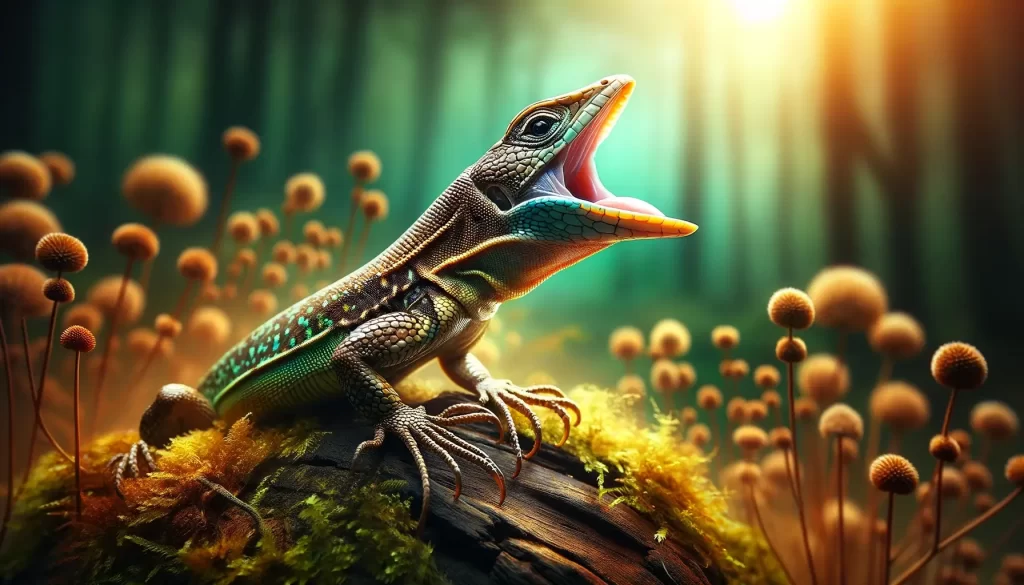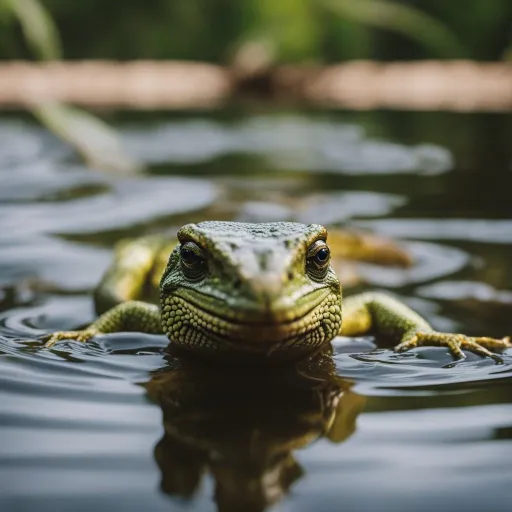Have you ever wondered if lizards can make noise? It’s a curious question that often sparks a lively debate among reptile enthusiasts.
While lizards are not known for their vocal abilities like birds or mammals, they do have ways of communicating that might surprise you.
Yes, some lizards can make noises, although they are generally not known for being noisy animals. The sounds they produce can include hisses, chirps, and clicks, which are used for communication, such as during territorial disputes or mating rituals.
In this article, we’ll explore the fascinating world of lizard noises and take a closer look at how these seemingly quiet creatures can actually make themselves quite vocal.
So, put on your lizard detective hat and get ready to uncover the secret language of these fascinating reptiles.
Types of Lizards
Anole Lizards
Anole lizards are a diverse group of lizards that belong to the family Dactyloidae.
They are known for their ability to change colors, which they often do to communicate with other members of their species.
However, when it comes to vocalizations, anole lizards are not known for being particularly noisy. They primarily rely on visual displays and body language to communicate.
Gecko Lizards
Gecko lizards, belonging to the family Gekkonidae, are known for their unique vocalizations.
These vocalizations are produced by rubbing their body parts together, particularly their specialized scales.
This friction produces a distinct chirping or clicking sound that geckos use to communicate with one another.
These vocalizations are most commonly heard during courtship or territorial disputes.
Chameleon Lizards
Chameleon lizards, from the family Chamaeleonidae, are famous for their ability to change colors to blend in with their surroundings.
However, when it comes to vocalizations, chameleons are not very vocal. They primarily rely on visual displays and body language, such as puffing up their throat or head, to communicate with other chameleons.
Iguana Lizards
Iguana lizards, belonging to the family Iguanidae, are generally not known for their vocalizations.
They communicate mainly through visual displays, such as headbobbing or push-ups, and through physical interactions.
However, some species of iguanas may produce hissing sounds, especially when they feel threatened or during territorial disputes.
Bearded Dragon Lizards
Bearded dragon lizards, from the genus Pogona, are popular pets known for their unique appearance and docile nature.
While they are not particularly vocal, they can make various noises to communicate. Bearded dragons may generate hissing or puffing sounds when they feel irritated or threatened.
Males can also produce a quiet, low-frequency rumble to attract females during mating season.
Monitor Lizards
Monitor lizards, from the family Varanidae, are a group of lizards known for their strong jaws and ability to climb trees and swim.
While they are not typically vocal, some species of monitor lizards can produce hissing or growling sounds when they are agitated or feel threatened.
These vocalizations serve as warning signals to potential predators or competitors.
Skink Lizards
Skink lizards, belonging to the family Scincidae, are a diverse group of lizards found worldwide. Most species of skinks are not known for their vocalizations.
They rely more on visual displays, such as tail-waving or color changes, to communicate with each other.
However, some skinks may produce faint chirping or squeaking sounds when they are distressed or during courtship.
Gila Monster Lizards
Gila monster lizards, from the genus Heloderma, are venomous lizards found in the southwestern United States and Mexico.
Despite their intimidating appearance, Gila monsters are not known for vocalizing.
They rely more on their venomous bite and strong body language, such as hissing or tail thrashing, to communicate with other Gila monsters or potential threats.
Tegu Lizards
Tegu lizards, from the genus Tupinambis, are large and intelligent lizards native to South America.
They are known for their sociable nature and can form strong bonds with their human caretakers.
While tegu lizards are not particularly noisy, they can produce hissing or huffing sounds when they feel threatened or during territorial disputes.
These vocalizations serve as warning signals to other animals in their environment.
Komodo Dragon Lizards
Komodo dragon lizards, from the genus Varanus, are the largest living species of lizard and are native to the Indonesian islands of Komodo, Rinca, Flores, and Gili Motang.
While they are not known for their vocalizations, they can produce various sounds when communicating with each other.
These sounds can range from low-frequency growls to hisses and moaning sounds. Komodo dragons primarily use these vocalizations during aggressive encounters or during courtship.
Lizard Vocalizations
Common Misconceptions
There are several misconceptions about lizard vocalizations. One common misconception is that all lizards are generally silent creatures.
While it is true that some lizards do not vocalize, many species have developed unique vocalization mechanisms to communicate with their surroundings.
Another misconception is that lizard vocalizations are always loud and easily noticeable.
In reality, many lizard vocalizations are quite subtle and may require attentive listening to detect.
Lizard vocalizations can range from soft chirps and clicks to low-frequency growls and hisses.
Lizard Communication
Lizard vocalizations play a crucial role in communication within their species. They use vocalizations to announce their presence, establish territories, attract mates, and convey different emotional states.
By understanding lizard vocalizations, we can gain valuable insights into their behavior and social interactions.
Vocalization Types
Lizards produce a variety of vocalizations to communicate with each other. Some common types of lizard vocalizations include chirping, clicking, hissing, growling, barking, and screeching.
These vocalizations are produced through different mechanisms, such as the respiratory system, vocal cords, vibrations, and tail movements.
Sound Frequencies
Lizards produce vocalizations across a wide range of sound frequencies. Some species produce high-frequency chirps or clicks, while others generate low-frequency growls or hisses.
The specific frequency range of lizard vocalizations may vary depending on the species, size, and environmental factors.
Vocalizations in Mating Season
During the mating season, many lizard species increase their vocalization activity. Males often produce distinct vocalizations to attract females and establish their dominance.
These vocalizations may include specific patterns, rhythms, or pitches that act as courtship signals.
Female lizards, in turn, may respond with their own vocalizations to indicate their interest or receptiveness.
Social Interactions
Lizard vocalizations also play a crucial role in social interactions within their communities. They can convey information about dominance hierarchies, territorial boundaries, and potential threats.
By analyzing vocalizations, researchers can gain insights into the complex social dynamics of different lizard species.

Factors Affecting Lizard Vocalizations
Lizard Species
Different lizard species have evolved unique vocalization abilities. Some species have well-developed vocal structures and produce a wide range of vocalizations, while others may be more limited in their vocal capabilities.
It is essential to consider the species-specific vocalization patterns when studying lizard vocalizations.
Size and Age
Size and age can also influence lizard vocalizations. Larger lizards often produce deeper and more resonant vocalizations, while smaller lizards may produce higher-pitched vocalizations.
Additionally, younger lizards may have less developed vocal structures, resulting in less elaborate vocalizations compared to adult individuals.
Environmental Factors
Environmental factors, such as habitat type and vegetation density, can affect lizard vocalizations.
Lizards in dense vegetation may need to produce louder or more complex vocalizations to overcome potential acoustic obstacles.
Open habitats may allow for easier sound transmission, resulting in different vocalization patterns.
Temperature and Humidity
Temperature and humidity can impact the activity levels and vocalizations of lizards. Species that are more active in warmer temperatures may also increase their vocalization activity during those conditions.
Humidity levels can affect the transmission of sound, potentially influencing the range or intensity of lizard vocalizations.
Time of Day
The time of day plays a role in lizard vocalizations, with some species being more vocal during specific periods.
Nocturnal lizards, for example, may produce more vocalizations during the nighttime, while diurnal lizards may be more active vocally during daylight hours.
Understanding the temporal patterns of lizard vocalizations can provide valuable insights into their behavior and ecology.
Predator Presence
The presence of predators can strongly impact lizard vocalizations. When faced with potential threats, lizards may produce alarm calls or distress vocalizations to alert others in the vicinity.
These vocalizations act as warning signals and help coordinate defensive responses within the lizard community.
Distinct Lizard Noises
Chirping
Chirping is a common vocalization produced by various lizard species. It is often a high-pitched and repetitive sound that serves multiple communication purposes.
Lizards may chirp to communicate their presence, attract mates, or establish territorial boundaries.
Chirping sounds can vary in intensity and duration, depending on the species.
Clicking
Clicking is another distinct lizard vocalization, often produced by gecko lizards. These clicking sounds are generated by rubbing specialized scales together, creating a unique and recognizable noise.
Gecko lizards use clicking vocalizations primarily during courtship or territorial disputes. The rhythmic clicking patterns can convey information about an individual’s fitness or intentions.
Hissing
Hissing is a commonly known vocalization produced by various lizard species. It is often associated with aggression, territorial defense, or distress.
Lizards may hiss by forcibly exhaling air, resulting in a distinctive noise. Hissing serves as a warning signal to potential threats, indicating that the lizard is ready to defend itself if provoked.
Growling
Growling is a vocalization produced by some lizard species, particularly larger ones. It is a low-frequency and often resonant sound that is associated with dominance and territoriality.
Male lizards may growl to assert their dominance over rivals or during courtship displays.
Growling can be accompanied by physical displays, such as headbobbing, to further communicate an individual’s intentions.
Barking
Barking is an uncommon but fascinating vocalization occasionally produced by certain lizard species.
It is characterized by short, sharp, and repetitive vocalizations that resemble a dog’s bark.
Barking is primarily observed in larger or more vocal species, such as some monitor lizards. It may serve as an alarm call or a territorial display.
Screeching
Screeching is a vocalization produced by certain lizard species, particularly during intense interactions or moments of distress.
It is a high-pitched and piercing sound that can be quite loud and attention-grabbing. Screeching can indicate fear, pain, or a warning to potential threats. It is often a last resort when other vocalizations or defensive displays fail to deter an aggressor.
Lizard Vocalization Mechanisms
Respiratory System
Lizard vocalizations are primarily produced through the respiratory system. Air is expelled from the lungs and forced through the larynx or vocal cords, creating the vibrations that generate sound.
Lizards have complex respiratory structures that allow for precise control over the production of vocalizations.
Vocal Cords
Lizards possess vocal cords, albeit in different forms and structures compared to mammals.
These specialized tissues within the larynx play a role in sound production. The tension and positioning of the vocal cords can influence the pitch, volume, and quality of lizard vocalizations.
Vibrations & Croaking
Some species of lizards produce vocalizations through vibrations or croaking. These lizards have specialized structures, such as inflatable sacs or membranes, that vibrate when air is expelled from their respiratory system.
The resulting vibrations generate unique and often resonant vocalizations.
Tail Movements
While not traditionally considered vocalizations, some lizards use tail movements to communicate.
Rapid tail vibrations, rattling, or drumming against the ground or vegetation can produce faint noises that are important in communication.
These tail movements and associated sounds often accompany visual displays, enhancing the overall signal to other lizards.
Foot Stampings
Certain lizard species use foot stampings as a form of communication and vocalization. By forcefully stamping their feet against the ground or their bodies against surfaces, lizards can produce distinct noises.
Foot stampings often serve as territorial displays or warning signals to other lizards in the vicinity.
Lizards That Do Not Make Noise
Silent Lizards
While many lizard species are capable of vocalizations, there are also numerous lizards that do not produce any noticeable sounds.
These “silent lizards” rely more on other forms of communication, such as body language, visual displays, or chemical signals, to communicate with each other and their environment.
Non-Vocal Lizard Species
Some lizard species have evolved without the ability to produce vocalizations. These non-vocal lizards rely solely on other communication methods, such as visual displays or chemical cues, to convey information.
The absence of vocalizations in these species highlights the diverse ways in which lizards have adapted to communicate within their respective habitats.
Reasons for Lizard Vocalizations
Mating and Courtship
One of the primary reasons for lizard vocalizations is mating and courtship. Male lizards often use vocalizations as part of their elaborate mating displays to attract females.
These vocalizations can act as courtship calls or love songs, indicating the male’s fitness and willingness to reproduce.
Females, in turn, may respond to these vocalizations, initiating the mating process.
Territorial Defense
Lizard vocalizations also play a crucial role in territorial defense. By producing specific vocalizations, lizards communicate their ownership over a territory and warn potential intruders to stay away.
These territorial vocalizations can be aggressive or confrontational, serving to establish dominance and prevent conflicts.
Aggression and Dominance
Intra-species aggression and dominance hierarchies are often communicated through lizard vocalizations.
Growls, hisses, or other aggressive vocalizations serve to intimidate rivals and assert dominance.
By vocalizing, lizards can avoid physical confrontations and establish their social standing within their community.
Fear and Distress
Lizards may vocalize when they are experiencing fear or distress. This vocalization serves as an alarm call to alert individuals in the area about a potential threat.
Fearful or distressed vocalizations can be loud and high-pitched, indicating the lizard’s need for help or signaling other members of their species to be cautious.
Warning Signals
Vocalizations also act as warning signals in the lizard community. Lizards may produce specific vocalizations to warn others of danger or potential threats.
These warning signals can prompt others to adopt defensive behaviors, such as fleeing or hiding, to avoid potential harm.
Vocalizations serve as an effective way for lizards to communicate important information rapidly within their community.
Lizards Mimicking Sounds
Imitating Other Animals
Lizards are highly adaptable creatures and can sometimes imitate sounds made by other animals.
This mimicry allows them to blend in with their surroundings or deceive potential predators or prey.
Some lizard species can imitate bird calls, insect sounds, or other animal vocalizations, showcasing their ability to adapt their vocal repertoire to their environment.
Bird Calls
Certain lizard species have developed the ability to imitate bird calls accurately. By mimicking the calls of birds, lizards can either deceive their predators or attract prey.
This mimicry highlights the incredible versatility of lizard vocalizations and their ability to take advantage of acoustic signals occurring in their environment.
Insect Sounds
Lizards may also mimic insect sounds, such as buzzing or chirping, to enhance their camouflage or lure prey closer.
By imitating these sounds, lizards can lower the suspicion of potential prey, increasing their chances of a successful hunt.
This mimicry demonstrates the complexity and versatility of lizard vocalizations as a means of survival.
Manmade Noise
In urban environments, some lizard species have been observed imitating manmade noises. This adaptation allows them to blend in with the background noise and avoid detection.
By mimicking sounds like car alarms or sirens, lizards can reduce the chances of being detected by potential predators or humans in their surroundings.
Research on Lizard Vocalizations
Scientific Studies
Researchers have conducted extensive studies on lizard vocalizations to understand their communication systems better.
These studies involve observing and recording vocalizations in the wild or in controlled laboratory settings.
Scientists analyze the acoustic properties, behavioral contexts, and potential functions of the vocalizations to unravel the complexities of lizard communication.
Field Observations
Field observations play a crucial role in studying lizard vocalizations. Researchers spend time observing lizards in their natural habitats, recording their vocalizations, and documenting their behavioral responses.
Field observations provide valuable insights into the social dynamics, mating strategies, and ecological adaptations related to lizard vocalizations.
Recording and Analyzing Lizard Sounds
Advancements in technology have allowed researchers to capture and analyze lizard vocalizations more accurately.
Specialized equipment, such as microphones and spectrographs, can record and analyze the acoustic properties of lizard sounds.
These recordings enable researchers to compare vocalizations across species, study their variations, and identify specific patterns or signals.
Comparative Analysis with Other Animals
Comparative analysis of lizard vocalizations with those of other animals, such as birds or mammals, provides valuable insights into the evolution of vocal communication.
By studying the similarities and differences between vocalization mechanisms, researchers can better understand the selective pressures and genetic adaptations that have shaped lizard vocalizations throughout evolutionary history.
Conclusion
Lizards, despite their reputation for being silent creatures, possess a diverse range of vocalization abilities.
From chirping and clicking to hissing and growling, lizard vocalizations serve various purposes, including mating, courtship, territorial defense, and warning signals.
Factors such as species, size, age, environmental conditions, and time of day influence the characteristics and prevalence of lizard vocalizations.
While some lizards are known for their vocal abilities, such as geckos and monitor lizards, others rely more on visual displays, tail movements, or other forms of communication.
Understanding lizard vocalizations is an ongoing area of research, providing valuable insights into the behavior, ecology, and evolutionary adaptations of these fascinating reptiles.
Frequently Asked Questions
Q: Why do house lizards make noise?
A: House lizards make noise, primarily chirping or clicking sounds, as a form of communication. These sounds can be related to territorial disputes, attracting mates, or expressing distress.
Q: What lizards can vocalize?
A: Several lizard species can vocalize, including geckos, which are known for their distinctive chirping sounds. Anoles and iguanas also have the ability to produce sounds.
Q: What kind of lizard sounds like a bird?
A: The Tokay Gecko is known for making loud calls that can sometimes be mistaken for bird sounds. Their vocalizations are distinctive and quite loud compared to other geckos.
Q: What does a gecko sound like?
A: Geckos can produce a variety of sounds, including chirps, barks, and clicks. The exact sound can vary by species, with some resembling birdlike chirps or more mechanical clicking noises.
Q: Do common house geckos make noise?
A: Yes, common house geckos make chirping noises, especially at night. These sounds are used for communication, such as establishing territory or attracting mates.
Q: Why do house geckos make noise at night?
A: House geckos are nocturnal, so they are most active and vocal during the night. Making noise at night serves various purposes, including communication with other geckos and mating calls.
Q: Do wall lizards make noise?
A: Wall lizards, like most lizards, are generally quiet, but they can make subtle sounds. However, they are not as vocal as species like geckos.




